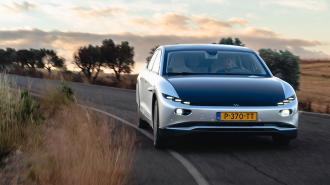Electric vehicle startup Lightyear has unveiled its first production-ready vehicle: a $254,000 solar electric car that the company says can go seven months without plugging in.
While the ultra-luxury price tag may be out of reach for most of us, the company promises a design that will start around $30,000 is in the works for 2024 or 2025.
The challenge: In the US, transportation emits more greenhouse gasses than any other sector, so convincing people to transition away from gas-guzzling vehicles and toward climate-friendly alternatives is a key part of stopping global warming.
But even climate-conscious drivers might hesitate to buy an EV due to the hassle of charging — topping off a battery can take hours, and fast charging stations aren’t yet ubiquitous.
“[Solar power] offers independence: you can just park your car and it will charge.”
Lex Hoefsloot
The startup: In 2013, students from Eindhoven University of Technology raced a solar car they’d built across nearly 2,000 miles of Australian outback to win their category at the World Solar Challenge.
A few years later, five of those students founded Lightyear with the goal of accelerating the global transition to EVs by using solar power to tackle the charging problem.
“It offers independence: you can just park your car and it will charge,” CEO Lex Hoefsloot told Auto Future in December 2021. “Solar cells have become increasingly cheap, and they provide you clean, free, and hassle-free energy.
Lightyear 0: After six years of development, Lightyear has now unveiled its first production-ready solar electric car: Lightyear 0.
The $254,000 luxury sedan was designed to be incredibly energy efficient — Lightyear didn’t even give it drag-producing side mirrors, opting instead for cameras — and as a result, it has a solid battery range of 388 miles.
The vehicle’s main selling point, though, is the 53 square feet of solar cells covering its exterior, which Lightyear says can provide up to 44 miles of range per day — in optimal weather conditions.
Lightyear plans to have a $30,000 solar electric car ready in 2024 or 2025.
According to the company’s testing, a person with a commute of 22 miles or fewer can go two months without charging the solar electric car if they live in a cloudy climate like the Netherlands. If they live somewhere sunnier, such as Spain, they could go seven months.
Lightyear expects to begin production on the solar electric car this fall, with the first customers receiving vehicles in November 2022.
Looking ahead: Lightyear 0 isn’t just expensive for a solar car or an electric vehicle — it’s expensive, period, and the transition to EVs isn’t going to be driven by a car that costs a quarter of a million dollars, regardless of the number of solar panels blanketing it.
That’s why Lightyear is planning to produce fewer than 1,000 of the luxury EVs before shifting its focus to Lightyear 2, a $30,000 solar electric car it hopes to have ready in 2024 or 2025.
“We’re trying to make the difference, not for the millionaire who can afford a [$254,000] car, but to get us to the point where the average person can … get a reliable sustainable vehicle that beats toe-for-toe any econo-box you can get at the time,” Telian Franken, the prototype team lead, told the Guardian.
We’d love to hear from you! If you have a comment about this article or if you have a tip for a future Freethink story, please email us at [email protected].






